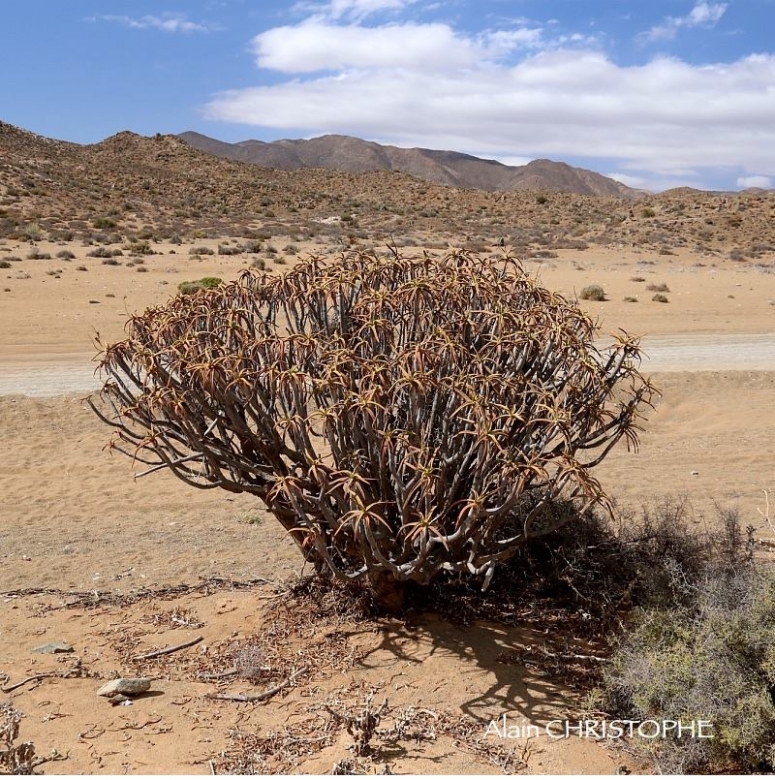
Aloe dichotoma subs. ramosissima Photo by: © Plantemania
Origin and Habitat: Southern Africa (Richtersveld), southern Namibia.
Habitat: The plants is from the winter rainfall of Southern Africa's Namib Desert and occur in very arid, rocky places on hills and mountains. They rely on winter rains that average around 110 mm or less per annum. It is not at all uncommon in this area for summer temperatures to rise to 46º C and years may pass before any rain falls.
Ecology: The bright yellow flowers produce nectar which is harvested by sugarbirds and ants. Generally, flowers are pollinated by bees and ants. When capsules dry out, the winged seeds are carried by the wind, often landing in bushes where they germinate, making full use of the shelter and shade. Plants eventually outgrow the nurse plant, killing it in the process. The fleshy leaves and stems act as water reservoirs in times of drought and the grey powder on the stems reflect intense heat away from the plant.
Synonyms:
See all synonyms of Aloe dichotoma
Common Names include:
ENGLISH: Maiden's Quiver Tree
AFRIKAANS (Afrikaans): Nooienskokerboom
Description: It is a slow growing tree (shrub) type aloe known for its many branches and smooth, white stems, and without a doubt the most profusely branched of all aloes. It will form a succulent bush up to 1,2(-1,8) m tall and wide. Other than this low branching habit and usually smaller leaf size, it is virtually identical to Aloe dichotoma, and some consider it a subspecies of A. dichotoma. Eventually forms large mounds.
Stems: As mentioned before, this aloe forms many branches from the ground level. This is the only significant difference between A. dichotoma and A. ramosissima. Branching continues as the plant becomes older, resulting in a dense, almost spherical shrub. The trunk is normally very short smooth and covered with strips of satiny, waxy, powdery silver-pink-brown coloured bark, which acts as a sunscreen in the harsh climate. The plants tends to be longer-stemmed and less branched in more arid areas.
Leaves: The branches end in small rosettes of fleshy, oblong leaves, each up to 200 mm long and 20 mm wide at the base. The leaf colour is glaucous-green or yellowish green, often with a pinkish tinge. The margins have narrow edges with small brownish teeth; base encircling the stem.
Flowers: Bright yellow, comparatively large, tubular, conspicuous, swollen, fleshy on a usually 3-branched short inflorescence, up to 200 mm long.
Blooming season: Winter: Definitely slow to flower, like Aloe dichotoma, takes quite awhile before it blooms, the first flower will be produced when plants gets 1-1,5 m of height (about 10 to 15 old).
Fruits: Shiny and smooth dry capsule that split into three, remaining fused at the base.
Seeds: Narrow, winged, up to about 30 x 18 mm.
Subspecies, varieties, forms and cultivars of plants belonging to the Aloe dichotoma group/complex
 Aloe dichotoma Masson: is a tree with rounded crown and may reach a height of 7 metres with up to 1 m of diameter at ground level. Distribution: South Africa (northern Cape) and Namibia.
Aloe dichotoma Masson: is a tree with rounded crown and may reach a height of 7 metres with up to 1 m of diameter at ground level. Distribution: South Africa (northern Cape) and Namibia. Aloe dichotoma subs. ramosissima (Pillans) Zonn.: is a slow growing small tree or shrub type aloe known for its many branches and smooth, white stems. Distribution: Southern Africa (Richtersveld), southern Namibia.
Aloe dichotoma subs. ramosissima (Pillans) Zonn.: is a slow growing small tree or shrub type aloe known for its many branches and smooth, white stems. Distribution: Southern Africa (Richtersveld), southern Namibia.
Bibliography: Major references and further lectures
1) Court, D., "Succulent Flora of Southern Africa" Cape Town: Struik Nature 2010
2) Susan Carter, John J. Lavranos, Leonard E. Newton, Colin C. Walker: "Aloes. The definitive guide." Kew Publishing, Royal Botanic Gardens, Kew 2011
3) Braam Van Wyk, Piet Van Wyk "Field Guide to Trees of Southern Africa" Struik, 1997
4) Olwen Megan Grace, Ronell R. Klopper, Gideon F. Smith, Neil R. Crouch, Estrela Figueiredo, Nina Ronsted, Abraham E. van Wyk: "A revised generic classification for Aloe (Xanthorrhoeaceae subfam. Asphodeloideae)." In: Phytotaxa. 76:1 7–14, 2013
5) Hans Bornman, David S. Hardy "Aloes of the South African veld" Voortrekkerpers, 1971
6) The Illustrated Encyclopedia of Trees and Shrubs: An Essential Guide to Trees and Shrubs of the World" MobileReference, 2008
7) Urs Eggli "Illustrated Handbook of Succulent Plants: Monocotyledons" Springer, 17/lug/2001
8) Gideon F. Smith, Braam Van Wyk "Aloes in Southern Africa" Struik, 01/set/2008
9) Barbara Jeppe "South African aloes" Purnell, 1974
10) Moran, R. "Aloe wild in California." Cact. Succ. J. (Los Angeles) 64: 55-56. 1992
11) Reynolds, G. W. 1982. "The Aloes of South Africa" ed. 4. Rotterdam.
12) Walter C. Holmes & Heather L. White: "Aloaceae in der Flora of Northern America" Volume 26, S. 410: Aloe
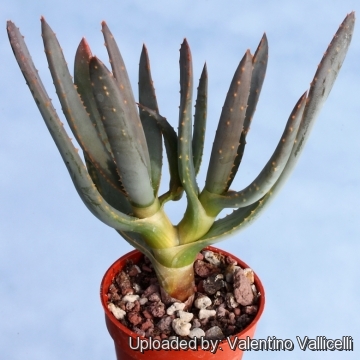 Aloe dichotoma subs. ramosissima Photo by: Valentino Vallicelli
Aloe dichotoma subs. ramosissima Photo by: Valentino Vallicelli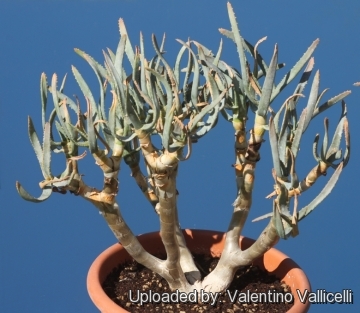 Aloe dichotoma subs. ramosissima Photo by: Valentino Vallicelli
Aloe dichotoma subs. ramosissima Photo by: Valentino Vallicelli Aloe dichotoma subs. ramosissima Photo by: Cactus Art
Aloe dichotoma subs. ramosissima Photo by: Cactus Art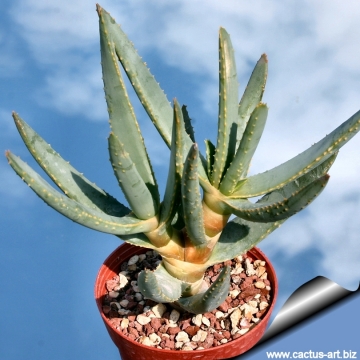 Aloe dichotoma subs. ramosissima Photo by: Cactus Art
Aloe dichotoma subs. ramosissima Photo by: Cactus Art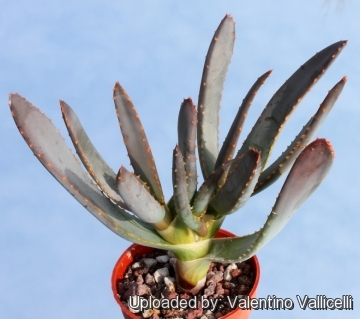 Aloe dichotoma subs. ramosissima Photo by: Valentino Vallicelli
Aloe dichotoma subs. ramosissima Photo by: Valentino Vallicelli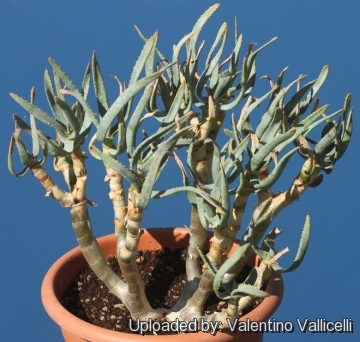 Aloe dichotoma subs. ramosissima Photo by: Valentino Vallicelli
Aloe dichotoma subs. ramosissima Photo by: Valentino VallicelliCultivation and Propagation: Winter grower, it is sometimes a tricky grower and prone to rot. Like its closest relative, Aloe dichotomaSN|647]]SN|616]], it has a very old and almost stressed appearance making this an excellent and sought-after container plant or wonderful landscape specimens in the garden, although it doesn't make a trunk.
Growing rate: They grow slowly, but not agonisingly so – being able to increase their height by 10 - 20 cm per year under favourable conditions. They are long lived plants and once established, they will be content in their position and with their soil for years.
Soil: Always use a good quality, loamy sandy soil with plenty of drainage chips at the bottom of containers.
Potting: It is best suited to being grown in a pot around here so that it has excellent drainage.
Fertilization: Need a perfect fertilizer diet in summer. Use preferably a cacti and succulents fertilizer with high potassium content including all micro nutrients and trace elements or slow release fertilizer.
Exposure: It can tolerate moderate shade, and a plant that has been growing in shade should be slowly hardened off before placing it in full sun as the plant will be severely scorched if moved too suddenly from shade into sun.
Watering: When growing this Aloe, one must be careful not to overwater.
Pest & diseases: Incorrect watering, poor drainage or too much shade can lead to attack by pests and diseases. Rot it is only a minor problem with aloes if the plants are watered and “aired” correctly. If they are not, fungicides won't help all that much.
Hardiness: They can take a few degrees of frost in winter as well, but prefer hot summers. It grows much better outdoors in spring and summer. If kept dry it is frost resistant and without trouble..
Gardening and landscaping: In mild climates they can be cultivated outdoors for use in landscaping, preferably planting it in hot and dry rock gardens. They will grow best in regions with a climate close to that of their native deserts – not too cold, and not too wet. They can be grown in large containers too.
Edible uses: The young flower buds can be eaten and have a similar appearance and taste to asparagus.
Other uses: Unlike Aloe dichotomaSN|616]]SN|616]], there are no cultural or medicinal uses associated with the maiden's quiver tree. However, it is known that the very young flower buds can be eaten and taste a little like asparagus. The branches of this plant were used to make small quivers by young men who then gave these quivers to young ladies as a sign of their affection.
Propagation: Plants grow easily from seeds and once germinated develop rapidly. It is possible to grow plants from cuttings but attempts are very seldom successful and therefore not advisable..The problem is they don't start to form roots until the start of the active growth season, which in begins in September. Seeds are able to survive for many months, but it is better to sow fresh seeds. Use coarse river sand mixed with fine compost, one part compost and two parts sand. Cover seed lightly and keep moist. One must be careful not to over-water and seedlings should be treated with a fungicide to avoid damping off. Seeds of Aloe ramosissimaSN|616]]SN|647]] are best sown in autumn.
Truncheons (if available) can also be used for propagation. Truncheons must be dried out for at least 3 weeks before planting in river sand. This is quite a difficult alternative and success is not always guaranteed.

















